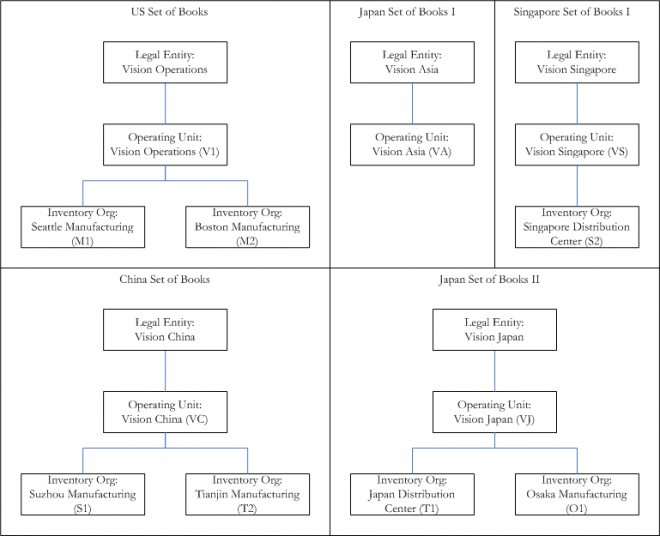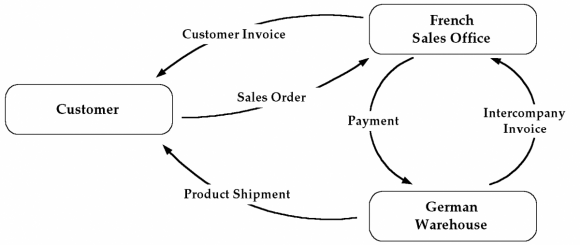Multiple Organizations Overview - R12
The Oracle Applications organization model defines organizations and the relationships among them in arbitrarily complex enterprises. This organization model serves as the cornerstone for all of the Oracle Applications products. It dictates how transactions flow through different organizations and how those organizations interact with each other.
Multi-Org is an application and database enhancement that enables multiple business units(operating units) in an enterprise to use a single installation of oracle applications products while keeping transaction data separate and secure.
Major Features of Multi-org
Multiple Organizations in a Single Installation
You can define multiple organizations and the relationships among them in a single installation of Oracle Applications. These organizations can be ledgers, business groups, legal entities, operating units, or inventory organizations.
Secure Access
You can assign operating units to a security profile and then assign the security profile to responsibilities or users. If multiple operating units are assigned to the security profile, then a user can access data for multiple operating units from a single
responsibility. This ensures that users can only access, process, and report on data for the operating units they have access to.
Data Security
You can limit users to information relevant to their organization. For example, you can limit access for order administration clerks to sales orders associated exclusively with their sales office.
Inventory Organization Security by Responsibility
You can specify the inventory organizations that are available to users in each responsibility. The Choose Inventory Organization window automatically limits available inventory organizations to those authorized for the current responsibility.
Responsibility Determines Operating Unit
Your responsibility determines which operating units you can access when you use Oracle Applications. If you only want a responsibility to access only one operating unit, then set the profile option called MO: Operating Unit. If you want a responsibility to access multiple operating units, then define a security profile with multiple operating units assigned and assign it to the MO: Security Profile profile option. Additionally, if using the MO: Security Profile profile option, you can also set the MO: Default Operating Unit profile option to specify a default operating unit that will default in transaction entry pages.
Types of Organizations
You can define organizations and the relationships among them. You can define security for either an organization hierarchy or list of organizations.
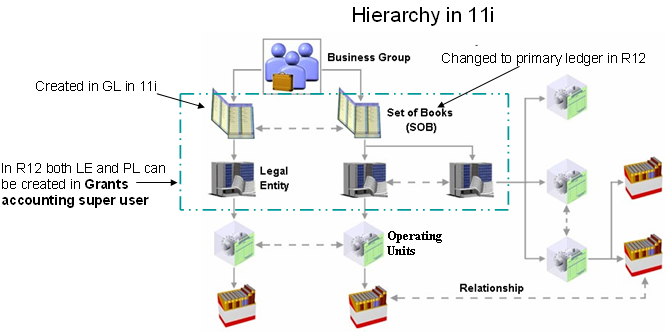
Business Group
The business group represents the highest level in the organization structure, such as the consolidated enterprise, a major division, or an operation company. The business group secures human resources information. For example, when you request a list of employees, you see all employees assigned to the business group of which your organization is a part.
 The business group drives the legislation used for human resources and payroll purposes. If the implementation involves employees in multiple countries, then it will likely require several different business groups, one for each country where employees are located. This assumes that the company does not seek to customize multiple legislative requirements into one business group.
The business group drives the legislation used for human resources and payroll purposes. If the implementation involves employees in multiple countries, then it will likely require several different business groups, one for each country where employees are located. This assumes that the company does not seek to customize multiple legislative requirements into one business group.

The HRMS best practice recommends that a new business group should represent a country or regional level partition of data. All companies that operate in the country or regions should be represented as legal employers in the business group.
SOB/PL
Set of books in 11i consists of 3Cs - Chart of Account, calendar, currency
Primary ledger in R12 consists of 4Cs
See the child chapter to this
http://www.oracleug.com/user-guide/basics-oracle/define-sob
Legal Entity
A legal company for which you prepare fiscal or tax reports. You assign tax identifiers and other legal entity information to this type of organization.
You can define legal entities using Legal Entity Configurator or Accounting Setup Manager in General Ledger.
Operating Unit
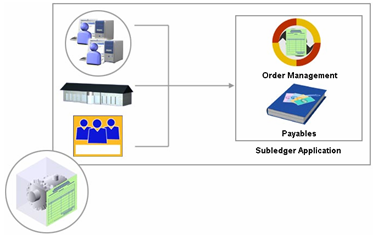
- An organization that uses Oracle subledgers, such as Oracle Cash Management, Order Management and Shipping Execution, Oracle Payables, Oracle Purchasing, Oracle Receivables, and related products. It may be a sales office, a division, or a department.
- In R 12 Operating units are not associated with legal entities. Operating units are assigned to ledgers and a default legal context.
- Information is secured by operating unit for these applications using responsibilities. Each user can access, process, and report on data only for the operating units assigned to the MO: Operating Unit or MO: Security Profile profile option. The MO: Operating Unit profile option only provides access to one operating unit. The MO: Security Profile provides access to multiple operating units from a single responsibility
- You can define operating units from the Define Organization window in Oracle HRMS or from Accounting Setup Manager in General Ledger.
Inventory Organization - An organization for which you track inventory transactions and balances, and/or an organization that manufactures or distributes products. Examples include (but are not limited to) manufacturing plants, warehouses, distribution centers, and sales offices.
- The following applications secure information by inventory organization: Oracle Inventory, Bills of Material, Engineering, Work in Process, Master Scheduling/MRP, Capacity, and Purchasing receiving functions. To run any of these applications, you must choose an organization that has been classified as an inventory organization.
- You can create ledgers using the Accounting Setup Manager in Oracle General Ledger and define organizations using the Define Organization window.
HR Organization
HR organizations represent the basic work structure of any enterprise. They usually represent the functional management, or reporting groups that exist within a business group. In addition to these internal organizations, you can define other organizations for tax and government reporting purposes, or for third party payments.
Information Shared Across Organizations
The following information is global. It must be set up once for the enterprise:
• Flexfield definitions
• Customer Header (customer site is at the operating unit level)
• Supplier Header (supplier site is at the operating unit level)
Inter Company
More and more companies are doing business globally, and taking advantage of the operations and tax benefits that can be achieved by running operations throughout the world. These companies have multiple operating units and organizations around the world. When goods are shipped or received, the financial ownership through these organizations does not necessarily follow the physical movement of goods. Oracle Applications support three main logistics needs of global organizations – Central Distribution, Central Procurement and Drop Ship.
- Central Procurement (P2P)
- Central Distribution (IR ISO)
- Drop Ship
1. External (O2C)
2. Internal (O2C)
A corporation manages its global operations in various countries through a network of subsidiaries, separate legal entities, licensees and several associated label franchisee. This complex network of operations is necessitated to take care of local legal and fiscal environment, which prevail in each of those countries.
Consider the below example:
Vision Operations (V1) is based in USA. It has a 100 % owned subsidiary company called Vision Asia (VA). VA in turn has two subsidiaries – Vision Japan (VJ) and Vision China (VC). VJ has manufacturing facilities in Osaka (O1) and distribution center at Tokyo (T1). Due to tax advantages, V1 sources all the goods from china through VJ. Though the financial transactions between V1 and VC are routed through VJ, logistic movement of goods takes place directly between V1 and VC.
Continuing the above example, Vision Operations (V1) has another subsidiary company called Vision Singapore (VS), 100 % that it owns. Individual plants procure components from their own suppliers. VS centralizes all the commodity (like steel, Aluminum etc.,) procurement needs of Vision Operations across Overview of Intercompany Invoicing 1 world and procures the material on behalf of all VJ and its subsidiary plants and places purchase orders on its suppliers. However, material is directly shipped from the suppliers to all the manufacturing plants.

Fig1
A key requirement for the global implementation of Oracle applications in such a complex business environment is the ability to process "intercompany transactions," where one business unit (across OUs)invoices another for transfer of goods and services. Often these intercompany transactions involve transactions related to general expenses, funds transfer, salary transfers, asset transfers, royalty payments and product transfers.
For example, the organization structure depicted in figure 1 can be modeled in Oracle applications as depicted in Figure 2.
Following are the key implementation points you need to look into: - Understand the corporation business entities and the relationship between them. Identify selling-shipping relationships and procuring-receiving relationships.
- Understand Oracle multi org structure and the building blocks in data structure.
- Breakup the business relationships into manageable process flow and map it to various entities in Oracle applications.
Multi Org(Multiple Organizations)
The Oracle Applications organization models define organizations and the relationships among them in arbitrarily complex enterprises. This organization model serves as the cornerstone for all of the Oracle Applications products. It dictates how transactions flow through different organizations and how those organizations interact with each other.
Generally, a complex enterprise has several organization structures, such as Internal, Accounting, and Human Resources. You are able to define different structures to customize Oracle Applications according to your business needs.
Basic Business Needs
Oracle Applications provides you with the features you need to satisfy the following basic business needs:
- Use a single installation of any Oracle Applications product to support any number of organizations, even if those organizations use different sets of books.
- Define different organization models
- Support any number of legal entities within a single installation of Oracle Applications.
- Secure access to data so that users can access only the information that is relevant to them.
- Sell products from a legal entity that uses one set of books and ship them from another legal entity using a different set of books, and automatically record the appropriate intercompany sales by posting intercompany accounts payable and accounts receivable invoices.
- Purchase products through one legal entity and receive them in another legal entity.
Major Features
Multiple Organizations in a Single Installation
You can define multiple organizations and the relationships among them in a single installation of Oracle Applications. These
organizations can be business groups, sets of books, legal entities, operating units, or inventory organizations.
When you run any Oracle Applications product, you first choose an organization—either implicitly by choosing a responsibility, or explicitly in a Choose Organization window. Each window and report then displays information for your organization only. Organizations that share the same functional currency, Accounting Flexfield structure, and calendar can post to the same set of books.
Secure Access
You can assign users to particular organizations. This ensures accurate transactions in the correct operating unit.
Sell And Ship Products From Different Legal Entities
You can sell from one legal entity and ship from another, posting to each organization’s set of books.
Receive Goods Into Any Inventory Organization
You can enter purchase orders and assign for receipt any inventory organization that uses the same set of books. Your purchase order operating unit and receiving inventory organization must share the same set of books to receive against a purchase order.
Automatic Accounting for Internal Requisitions
You can create an internal requisition (sales order) in one organization, then ship from another organization, with correct intercompany invoicing.
Multiple Organizations Reporting
You can set up your Oracle Applications implementation to allow reporting across operating units by setting up the top reporting level. You can run your reports at the set of books level, legal entity level, or operating unit level
Types of Organizations
You can define organizations and the relationships among them.
You create sets of books using the Define Set of Books window in Oracle General Ledger. You define all other types of organizations using the Define Organization window.
1. Business Group
The business group represents the highest level in the organization structure, such as the consolidated enterprise, a major division, or an operation company. The business group secures human resources information. For example, when you request a list of employees, you see all employees assigned to the business group of which your organization is a part.
Note: This is true in all applications except the HR applications, which support more granular security by a lower–level organization unit, the security profile. Multiple sets of books can share the same business group if they share the same business group attributes, including HR flexfield structures.
2. Set of Books
A financial reporting entity that uses a particular chart of accounts, functional currency, and accounting calendar. Oracle General Ledger secures transaction information (such as journal entries and balances) by set of books. When you use Oracle General Ledger, you choose a responsibility that specifies a set of books. You then see information for that set of books only.
3.1 Legal Entity
A legal company for which you prepare fiscal or tax reports. You assign tax identifiers and other legal entity information to this type of organization.
Note: There are currently only a few features provided for legal entities, such as intrastat movement reports and
intercompany invoice generation.
3.2 Balancing Entity
Represents an accounting entity for which you prepare financial statements. This is a segment in the Accounting Flexfield structure (usually the Company segment) at which all accounting entries must balance. There may be multiple companies within the same structure, and each of these must balance within itself. Each legal entity can have one or more balancing entities. You can use Flexfield Value Security rules to restrict data entry of balancing segment values by legal entity
or operating unit.
4. Operating Unit
An organization that uses Oracle Cash Management, Order Management and Shipping Execution, Oracle Payables, Oracle
Purchasing, and Oracle Receivables. It may be a sales office, a division, or a department.
An operating unit is associated with a legal entity.
Information is secured by operating unit for these applications. Each user sees information only for their operating unit. To run any of these applications, you choose a responsibility associated with an organization classified as an operating unit.
5. Inventory Organization
An organization for which you track inventory transactions and balances, and/or an organization that manufactures or distributes products. Examples include (but are not limited to) manufacturing plants, warehouses, distribution centers, and sales offices. The following applications secure information by inventory organization:
Oracle Inventory, Bills of Material, Engineering, Work in Process, Master Scheduling/MRP, Capacity, and Purchasing receiving functions.
To run any of these applications, you must choose an organization that has been classified as an inventory organization.
6. HR Organization
HR organizations represent the basic work structure of any enterprise.
They usually represent the functional management, or reporting groups that exist within a business group. In addition to these internal organizations, you can define other organizations for tax and government reporting purposes, or for third part payments.
7. Organizations in Oracle Projects
Oracle Projects allows you to define organization hierarchies to reflect your company’s organizations structure. You can add Oracle Projects–specific organization types to the organization hierarchy (for example, projects organizations or Expenditure organizations) to help you to better manage your project control requirements. You assign project and expenditure hierarchies to operating units.
8. Asset Organizations
An asset organization is an organization that allows you to perform asset–related activities for a specific Oracle Assets corporate depreciation book. Oracle Assets uses only organizations designated as asset organizations
Human Resources Organization Model
With Oracle Human Resources, you can define multilevel organization hierarchies, with a business group at the top of each hierarchy. When you define new organizations, they are automatically assigned to the business group associated with your current session. Each organization is part of a business group. The business group is usually the top box on an enterprise organization chart, as shown in below figure.
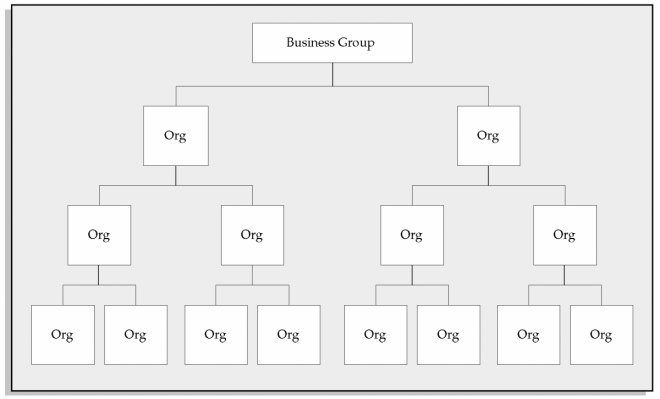
The business group is the largest organization unit you set up in Human Resources to represent your enterprises as an employer. After defining one or more business groups for your enterprise, you set up one or more government reporting entities (GREs) within each business group. The GRE is the organization that federal, state, and local governments recognize as the employer.
Below this level, you represent the groupings in which employees work, such as branches, departments, or sections, by means of internal organizations. To enable the assignment of employees to an internal organization, you classify the internal organization as an HR organization.
You can define external organizations in the same way as internal organizations, so that you can represent organizations that are not part of your enterprise (such as training vendors or tax offices). The major difference between internal and external organizations is that you cannot assign people to an external organization.
Accounting / Distribution / Materials Management Organization Model
Using the accounting, distribution, and materials management functions in Oracle Applications, you define the relationships among inventory organizations, operating units, legal entities, and sets of books to create a multilevel company structure, as shown in below Figure.

Legal Entities Post to a Set of Books
Each organization classified as a legal entity identifies a set of books to post accounting transactions.
Operating Units Are Part of a Legal Entity
Each organization classified as an operating unit is associated with a legal entity
Inventory Organizations are Part of an Operating Unit
Each organization classified as an inventory organization references an operating unit.
Inventory Organization Determines Items Available to Order Management
The Item Validation Organization parameter specifies which Oracle Manufacturing organization is used to validate inventory items. You must define all transactable items in this organization. Some inventory item attributes for Receivables and Order Management, including Tax Code and Sales Account, are specific to an operating unit or an accounting flexfield structure. Therefore, you should define an item validation organization for each operating unit.
Inventory Organization Determines Items Available to Purchasing
The inventory organization you specify in the financial options for each operating unit determines the items available in Purchasing. You can only choose an inventory organization that uses the same set of books as your operating unit.
Security Control
Controlling Secure Access
Data Security
You can limit users to information relevant to their organization. For example, you can limit access for order administration clerks to sales orders associated exclusively with their sales office.
Inventory Organization Security by Responsibility
You can specify which inventory organizations are available to users in each responsibility. The Choose Inventory Organization window automatically limits available inventory organizations to those authorized for the current responsibility.
Responsibility Determines Operating Unit
Your responsibility determines which operating unit you access when you use Oracle Applications. When you use Oracle Payables, Receivables, Order Management and Shipping Execution, Purchasing, Projects, and Sales Compensation you see information that is relevant to your operating unit. All transactions you create are automatically assigned to your operating unit.
Sell And Ship Products From Different Legal Entities
Sell from One Legal Entity, Ship from Another Legal Entity
When you enter sales orders, you can choose any inventory organization as the shipping warehouse. The shipping warehouse may be in a different legal entity than the operating unit that enters the sales order, and it may post to a different set of books.
Use the Choose Organization Window to Choose Inventory Organization
After you choose your responsibility to perform materials management functions using Oracle Inventory, Work in Process, Bills of Materials, Master Scheduling/MRP, Capacity, or Purchasing, you must use the Choose Organization window to pick an inventory organization.
Intercompany Accounting
Automatic Intercompany Sales Recognition
Sales orders created and shipped from one legal entity to a different legal entity automatically generate an intercompany invoice to record a sale between the two organizations.
Posting Intercompany Invoices to Different Accounts
You can define different accounts for Trade and Intercompany Cost of Goods Sold and Sales Revenue to eliminate intercompany profit.
Report at the Legal Entity or Set of Books Level
In addition to reporting at the operating unit level, you can report at the legal entity or set of books level.
Setting up Multi Org
Adding a New Operating Unit
The following steps are required to add new operating units to your organizational structure:
1.1 Revise the Organization Structure.
1.2 Define Sets of Books (optional).
1.3 Define Locations.
1.4. Define Organizations and Relationships.
2.1 Define Responsibilities.
2.2 Set Profile Options for Each Responsibility linked to the new Operating Unit.
1.1. HR: Business Group
1.2 HR: Security Option
1.3: HR: User Type (FOR accessing HRMS functions)
1.4 HR: Cross Business Group
2.1. GL: Set of Books(11i)
2.1 GL:%Ledger% (R12)
2.3 GL: Data Access Set. This profile option to control the ledgers that can be used by Oracle General Ledger.
3.1. MO: Operating Unit
3.2. MO: Security Profile (R12)
3.3. MO: Default Operating Unit
4.1 Tax: Allow Override of Tax Code
4.2 Tax: Invoice Freight as Revenue
4.3 Tax: Inventory Item for Freight
5.1 Sequential Numbering
5.2 INV: Intercompany Currency Conversion
2.3 Run the Replicate Seed Data concurrent program.
3.1 Define Inventory Organization Security.
3.2 Define Intercompany Relations (optional).
3.3 Implement the Application Products.
4.1 Secure Balancing Segment Values (optional).
4.2 Run the Setup Validation Report (recommended).
4.3 Implement Document Sequencing (optional).
4.4 Set the top reporting level (optional).
4.5 Set up conflict domains (optional).
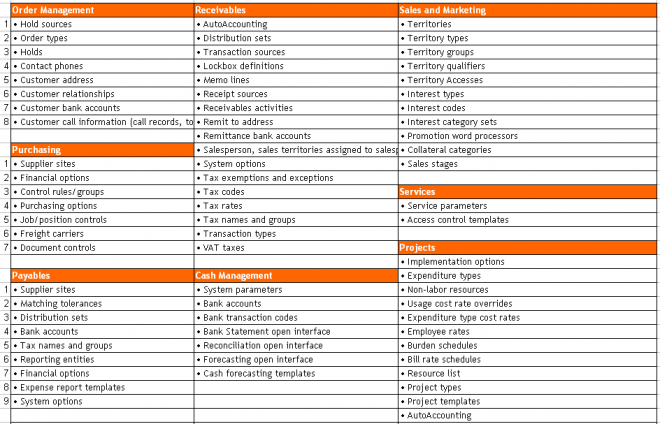
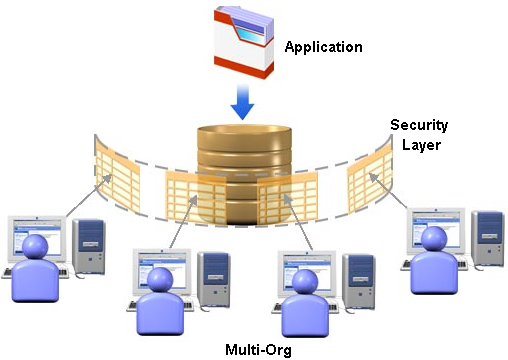

 The business group drives the legislation used for human resources and payroll purposes. If the implementation involves employees in multiple countries, then it will likely require several different business groups, one for each country where employees are located. This assumes that the company does not seek to customize multiple legislative requirements into one business group.
The business group drives the legislation used for human resources and payroll purposes. If the implementation involves employees in multiple countries, then it will likely require several different business groups, one for each country where employees are located. This assumes that the company does not seek to customize multiple legislative requirements into one business group.



